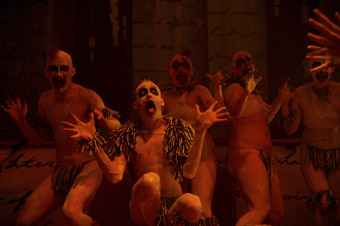under a spell
douglas leonard: zen zen zo, the tempest

Calibans, Zen Zen Zo, Tempest
photo Simon Woods
Calibans, Zen Zen Zo, Tempest
THERE IS SOMETHING SWEET, ENTIRELY SINCERE, SOMETHING WHOLLY OWNED BY THE CAST AND CREW OF ZEN ZEN ZO PHYSICAL THEATRE’S ADAPTATION OF SHAKESPEARE’S THE TEMPEST THAT WEAVES ITS OWN SPELL. THE TEMPEST HAS BEEN DESCRIBED AS AN ATTEMPT TO ENVISION UTOPIA WITHOUT UTOPIANISM, AND THERE’S SOMEHOW AN OVERDETERMINATION IN THIS PRODUCTION THAT SEEMS TO BE SUITED TO THE NATURE OF SHAKESPEARE’S PLAY.
It doesn’t simply stem from the energy of the mainly young cast or the eclectic fusion of high art and pop culture tailored for young audiences, but from what can only be described as a residual faith in art on its ultimate borders where, as the critic Leslie A Fiedler points out, it becomes indistinguishable from sorcery. This production actually contemplates a transformation in the fundamental structures of everyday life, a concept that shouldn’t be so astonishingly novel nowadays when it seems nothing less will halt the headlong destruction of the planet. The Tempest is the most quotable of Shakespeare’s plays, including that one line about the whole globe dissolving, leaving not a rack behind.
Lynne Bradley’s director’s notes announce that the core message of the company’s version of The Tempest is that “it is every human being’s imperative to struggle for freedom—both political and personal.” All the characters, including Prospero himself, struggle to be freed from some kind of internal or external entrapment—to write, as it were, their own scripts. It is the courtiers and the politicians who are enmired. As we enter the space, we notice that visual director Simon Woods has writ large across the cavernous Concert Hall walls what look like reproductions from the Folio manuscripts, simultaneously creating the dioramic impression of waves round Prospero’s island and generating notions of the text as either a set of discourses or set in stone by claims made in the name of The Tempest’s timelessness and transcendence. Later on, with gesturing hands, Prospero will visibly underscore the demeaning irony of being trapped inside another person’s script against this backdrop. The Tempest is a play in which the word ‘strange’ is the most frequently used adjective, and we are inducted into this promenade style theatre by wandering among living statues, tableaux of the actors who are not simply still but emanate that ‘ferociousness of being’ that Rilke attributes to the presence of his angels. The atmosphere is ‘strange’, but it is we who are the strangers.
Zen Zen Zo aim to create total theatre, with “the spoken, physical, visual and aural texts all playing equal roles in imparting the meaning.” They are also a training institute, which accounts for their need for a large cast in order to incorporate students. Physical disciplines predominate, including the Suzuki Method, Butoh and Contact Dance. All three are usefully in there, but it is the Butoh movement adopted wholesale by the Caliban Chorus that amounts to a conceptual as well as physical tour de force. Zen Zen Zo has drawn from post-colonial readings of the play, and the Calibans are portrayed somewhat as the American Indian tribes encountered by English settlers in Shakespeare’s time (Pocahontas met Ben Jonson): almost naked, hair tufts and terrifying facial war paint. These Ur-Indians who are also Butoh exponents might seem a bridge too far, but they could hardly be real Indians. Caliban was part fish, already ersatz. They are the European Other everywhere who must be taught language (as Prospero teaches Caliban) as a technique of colonial rule. In fact, the Calibans are the fantasy of the Other owned up to, swallowed and vomited forth—quite horrifying in the permutations of their degradation by the insouciant in-comers to the island. I flinched. What was magnificent, in balance, was the log rebellion, the mass enaction of Caliban’s suggestion to his outlander co-conspirators, Stephano and Trinculo, that they stave in Prospero’s head. Dale Thorburn articulated Caliban’s position well.
Music is the foundation of The Tempest: “Sounds and sweet airs that give delight and hurt not.” The music makers on stage are Ariel and Prospero, cabaret artiste Emma Dean and classic actor Brian Nason, doyen of his own Grin and Tonic Theatre Company in Brisbane: natural collaborators in terms of the play. Offstage the composers were Emma Dean and Colin Weber. Dean is a physical dynamo, snazzy, a musical virtuoso (piano and violin) and, indeed, the flighty Ariel threading the show. Nason is the ground. Properly irascible as his Prospero is, as internally conflicted, he has a lute player’s touch on Shakespeare’s language. Even in the soundaround his performance chimed. His final exchange with Caliban—“this thing of darkness I acknowledge mine”—shone with heartbreaking lambency.
Zen Zen Zo Physical Theatre, The Tempest, director Lynne Bradley, visual director Simon Woods, performers Bryan Nason, Emma Dean, Dale thorburn, Jill Guerts, Alex Mikic, Jamie Kable, Jane Cameron, Luke Kerridge, Alice Flynn, Carolyn Eccles, Jess Samin, Natalie Bak, Brigid Blanckenberg, Caesar Cordovana, Jamie Kendall, Alison McGregor, Emma Bleanay, Harriet Devlin, Krystal Hart, Oliver Skrzypczynski, Lisa Worthington, composers Emma Dean, Colin Webber, lighting designer Jason Glenwright, costume designer Angela White, set designers Drew der Kinderen, Lynne Bradley, Luke Kerridge; Old Queensland Museum, Brisbane, June 2-July 1
RealTime issue #92 Aug-Sept 2009 pg. 42






